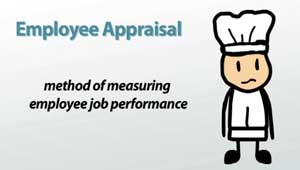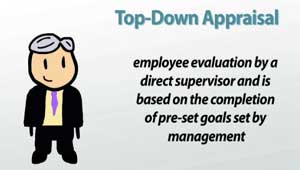Performance Appraisal and 360 Feedback
After you watch the video and know the material, click HERE for the quiz.
Employee evaluations are a way managers can assess job performance and provide feedback to employees. An employee's performance is measured using various types of evaluation systems, including top-down appraisal, management by objectives (MBO), self-assessment and 360 degree feedback.
Employee Performance Checkpoints
Measuring employee performance is similar to a cook tasting a pot of soup as ingredients are added. Each checkpoint, or taste of the soup, tells the cook what needs to be done to make the soup taste right. He begins with a recipe, gathers ingredients, begins cooking and tastes along the way. When he is done, his customers evaluate the soup by enjoying it or spitting it out. Employee appraisals work the same way.
 |
An employee appraisal is a method of measuring employee job performance. The employee appraisal consists of regular reviews at different intervals, generally every six months or yearly. Employee appraisals are based on a predetermined set of criteria, generally centered on organizational goals and measures things like:
- Behaviors
- Productivity
- Strengths and weaknesses
Commonly Used employee Appraisals
There are several types of appraisals that can be used to evaluate an employee's performance. The most commonly used appraisals are:
- Top-down appraisal
- Management by objectives (MBO)
- Self-assessment
- 360 degree feedback
Top-Down Appraisal
 |
Top-Down Appraisal is used most commonly, involves an employee evaluation by a direct supervisor and is based on the completion of pre-set goals set by management. Productivity, behavior and goal completion are generally measured. Outcomes of this method are used for raises and promotions.
Miss Nelly, owner of Nelly's Noodle Soup, sets goals for soup production and sales. Employees are given the criteria for their appraisal for how many soups to make and sell each day. At different intervals, like when they are hired and at each appraisal period, Nelly calculates the production and sales. This is compared to the criteria and then feedback is given.
Management by Objectives (MBO)
Management by Objectives, also called MBO, involves management and employee collaboration on goal setting. Once goals have been set and agreed upon, management uses the outcomes to provide feedback.
Higher-level employees, like shift managers, are evaluated differently. Because managers are responsible for so much more than the taste of the soup, the evaluation method should be more collaborative. Nelly and the manager will work together on the organizational goals. Once agreement has been met, the manager will be responsible for completing the goals.
Self-Assessment
Self-Assessment is an assessment of performance done by the employee himself or herself.
 |
The employee will compare his actual performance to that of the goals that were set for him. Outcomes of this method are generally goal attainment, behavioral, problem solving skills, communication skills and teamwork. There is generally a professional development or growth plan developed by the employee that lists ways in which the employee plans to increase his or her performance. This may include additional training, education or higher productivity goals.
 |
Nelly also likes to have all employees take an inventory of their own performance. This is a good checkpoint for employees to reflect on their performance over a period of time. She uses this method mainly to determine any changes she can make to develop her employees.
360 Degree Feedback
 |
360 Degree Feedback is a form of feedback about an employee's performance from many different people within the company and outside the company. Feedback is gathered from multiple perspectives, based on the relationship between the parties. Feedback is given from those internal to the company, like subordinates, peers, supervisors and oneself, and externally from customers and vendors. The feedback is used as a roadmap to develop the employee's competencies and set goals. This method is generally not linked to pay or promotion. It is used mainly for self-development.
The general manager is evaluated using feedback from many different sources like Nelly, the cooks, customers and vendors. This approach produces valuable feedback from many vantages.
Lesson Summary
An employee appraisal is a method of measuring employee job performance. Appraisals are used to evaluate whether employees are meeting their goals. Appraisals are done at different intervals, generally every six months or yearly, and measure things like behaviors, productivity and strengths and weaknesses. Managers use several types of appraisals:
- The top-down appraisal is a commonly used method and involves measuring employee performance based on goal completion.
- Management by objectives (MBO) takes a more collaborative approach because it involves the manager and employee setting objectives together.
- Self-assessment is more reflective, because the employee actually sets his or her own goals for development and assesses the outcomes.
- 360 degree feedback, unlike the other appraisal methods, involves many people from within and outside the organization. Each person provides feedback about the employee in their specific relationship.